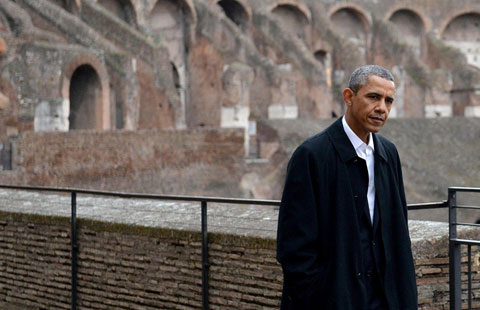Making Chinese easier by dissecting its pictographic roots
Updated: 2014-03-31 05:58
By CHRIS DAVIS in New York (China Daily Latin America)
|
||||||||
The daunting Chinese language barrier may not be all it's cracked up to be. Charismatic, attractive Taiwan-born Shao Lan has invented a new way for Westerners to find their way around it, one that goes beyond the rigors of rote memorization and instead explores the ancient artful roots of Chinese calligraphy.
The system is called Chineasy, its website and facebook page are up and running, the English-language book was just unveiled London and New York, and books in Spanish, Portuguese, German, French, Dutch are due shortly.
"Chinese is not the easiest language, for sure," Shao Lan said. "But at the same time it's not as hard as people think."
The beauty of Chineasy is that is penetrates the enigmatic language by taking apart its pictographic construction and making people understand how it works piece by piece before trying to dive in.
Shao Lan — who studied chemistry and business in Taiwan and international studies at Cambridge — said she has an analytical mind.
Now living in London, she said Chineasy all started when she realized that her British-born children were not all that interested in learning Chinese. After trying several different methods — all she found extremely challenging — she decided to do it for herself.
What seemed daunting at first, turned out to be fun. ShaoLan's mother was a calligrapher and as a child she had always been fascinated by the beauty of the characters. She was also deeply interested Chinese culture — the history, language and literature — so it was only natural for her to riddle out how the characters came to look as they did.
"When I see things I see patterns," she said. "When I see Chinese characters, I try to identify the patterns."
In London, she started to break down Chinese characters — which are composed of one to four or five "building blocks" — by the hundreds, then thousands, first on paper and eventually on a computer as the task grew geometrically.
What evolved was a kind of three-dimensional interactive matrix that looks like something out of a science fiction movie.
"So you can see that each character is made of many other components," she explained. "Once you understand the correlation, it is actually much easier."
For example, the character for "burning" is made out of one "fire" and two "trees".
The characters "woman" and "mouth" together mean "obey". "It says a lot about Chinese history and historical reference," Shao Lan said.
Chineasy's website and facebook page go into great detail on the origin of each character, but not everyone can be authenticated, the character for "idiot" being a prime example. "I simply could not find why a ‘mouth' on top of a ‘tree' means ‘idiot'," Shao Lan said.
When this happens, Chineasy offers lighthearted explanations that are obviously jokes — a talking tree sounds very idiotic, or if you open your mouth wide to try and swallow a tree, that looks very idiotic.
Character origins also betray cultural heritage. The character for "woman" traditionally is the outline of a figure kneeling on the floor, showing subservience. "I am very frustrated by the origin of this character," she said.
Put two "woman" characters together and it means "argument". "By Chinese tradition, even nowadays, a lot of families have three or four generations living under the same roof. And because only sons are important, daughters are not, every family wants to preserve their lineage and the mother-in-law will always consider the daughter-in-law someone who wants to steal their children away from them. So inevitably there's always a little conflict in the family."
She insists that the language barrier is "overrated".
"How many languages are there in the world whose ancient forms are similar to their modern forms?" Shao Lan asks. Chinese seems to be the only one, not counting Greek and Sanskrit, of course.
"Why can it last for such a long time and why can 1.3 billion people learn it and the rest of the world can't? I don't believe it." Any language with that kind of legs and staying power "has to be so easy that it can be carried on and used and modified", she argued.
Utility is not the immediate goal of Chineasy. "I'm trying to put something together that is literature, culture, social, history, art. I'm not here to serve the purpose of like Sesame Street or Rosetta Stone."

 Xi watches China-Germany youth football match in Berlin
Xi watches China-Germany youth football match in Berlin
 Participants run for color
Participants run for color
 Indian air force cargo plane crashes, killing 5
Indian air force cargo plane crashes, killing 5
 Highlights of the Baselworld 2014
Highlights of the Baselworld 2014
 Obama tours the Colosseum
Obama tours the Colosseum
 Green Snake premieres in DC; an enchanting mystery
Green Snake premieres in DC; an enchanting mystery
 Trans-Pacific-City, State bonds celebrated
Trans-Pacific-City, State bonds celebrated
 Remains of Chinese soldiers in Korean War return
Remains of Chinese soldiers in Korean War return
Most Viewed
Editor's Picks

|

|

|

|

|

|
Today's Top News
Xi pledges to bolster ties with Belgium, EU
No substantive findings for MH370
Fujian relaxes one-child policy
Overseas returnees vie for jobs
Putin calls Obama to talk Ukraine
China, Germany to build yuan center
Turkey labels YouTube leak a 'plot'
DPRK lashes out at ROK 'gangsters'
US Weekly

|

|








